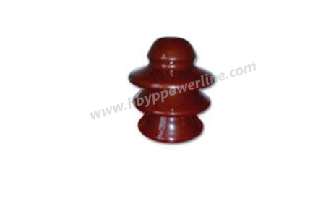Common methods for judging the surface contamination of high-voltage insulators are: equivalent salt density method; overall surface conductivity method; leakage current pulse counting method; leakage current equivalent method, etc.: the current power supply department's judgment on the pollution degree of transmission line insulators-generally all It can only be used to measure the equivalent salt density method, but this method still has the following shortcomings.
(1) The composition of the contaminants on the surface of the high-voltage insulator is very complicated. Through analysis of the chemical composition of the contaminants, it is found that the contaminants contain more CaSO4, which is a more insoluble substance. The amount of distilled water will wash away the dirt that is insulated on the surface. The conductivity of the solution is measured to convert the equivalent salt density. In these distilled water, CaSO4: most of it is soluble. In fact, the surface of the insulator is arc-shaped, with less water, and only a small part of CasO4 is soluble. Therefore, the measured equivalent density of high-voltage insulators with salt usually does not completely represent the effect of the true pollution degree of high-voltage insulators on its insulation performance.
(2) Sometimes the contaminated layer formed on the surface of the high-voltage insulator is thick, and the soluble substances inside the contaminated layer are difficult to dissolve in the water on the surface of the high-voltage insulator. In the equivalent salt density test, all the contaminated substances on the surface of the high-voltage insulator are cleaned Come down and experiment. It can be seen that for high-voltage insulators with different thicknesses of contaminated layers, even if the equivalent value is attached to the salt density value, the insulation level of the insulator is actually different.

High Voltage Insulator
(3) The surface of the high voltage insulator is washed by the rain and blown by the wind, which will reduce part of the pollution. Due to the different meteorological conditions of the environment where the high voltage insulator is located, or due to some specific factors, it will cause the pollution of the surface of the high voltage insulator Unevenness. The equivalent salt-attached density method is converted to the measured surface area of the high-voltage insulator, which is an average value. In fact, sometimes the equivalent salt-attached density value is not large, but serious local pollution will still lead to a decrease in insulation level, and bird droppings will cause high-voltage insulator strings Flashover is a typical example: when some units have regularly cleaned transmission lines, due to the weak sense of responsibility of the staff, a small part of the entire string of high-voltage insulators away from the pole tower was not cleaned. After the pollution flashover accident, the high-voltage insulators were In the equivalent salt density test, it was found that the value did not exceed the salt density value configured according to the requirements of the polluted area grade at the location of the line tower.
The Power Line Fittings supplier reminds you that the measurement equivalent salt density method currently used to judge the pollution level of high-voltage insulators is not very scientific and reasonable.
+86 319 878 9350
+86 156 1304 7999
+86 319 878 9350
NanYan, DongHuan Road, Shahe, Hebei China
Copyright © Hebei Yipeng Line Equipment Co., Ltd. All Rights Reserved. | Sitemap Powered By 
